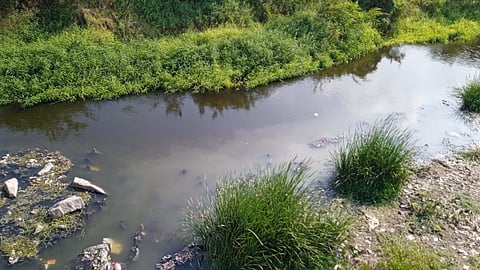

TIRUPPUR : Even though discharge from effluent treatment plants (ETP) has stopped completely, the Noyyal river water remains unfit for drinking, as sewage is discharged into it at many places in Tiruppur city. Expediting work on sewage treatment plants being constructed by the city corporation is therefore necessary.
TNPCB records say on February 26 officials conducted a field water study with hand-held Total Dissolved Solids (TDS) meters at several spots along the river in the city. TDS in water samples taken at Somanur village (entry point towards Tiruppur city) was 1,610 mg per litre. But in water samples taken at Athupalayam in Tiruppur city, it was 2,160 mg per litre. This renders it unfit for drinking, as home-based domestic reverse osmosis (RO) units cannot process water that has TDS of 2,000 mg per litre.
Speaking to TNIE, an official from Tamil Nadu Pollution Control Board (TNPCB) - Tiruppur north zone, said, “Earlier when dyeing units used to discharge effluent, TDS was around 8,000 mg-10,000 mg per litre. This was very severe, but things changed after the installation of Common Effluent Treatment Plants (CEPTs) in early 2013. Within two years, there was zero discharge in the Noyyal river and the water flow attained its normal level. However, we continued to test water samples and checked the salt and chemical dissolved in the water in many spots of the river. We found variation in many spots."
"The river enters Tiruppur district near Sulur and Somanur section, and the sample showed TDS of 1,000-1,500 mg per litre, but after it enters the city, it was more than 2,000 mg per litre. The jump of 600 mg per litre is primarily because of sewage discharge from Tiruppur city. This cannot be processed by normal reverse osmosis units in houses.”
Noyyal river farmers welfare association coordinator KS Thirunana Sambandam said, “Earlier, many residents used to have a soak pit, which was an essential part of the home drainage system. It helped in collecting and disposing of waste water safely from their houses. In the 1990s, effluent from dyeing units increased and the issue was resolved after the establishment of CEPTs. However, sewage increased from the households, and no action was taken from Tiruppur City Corporation. We are saddened by the ecological damage created by sewage water to the Noyyal river.”
An official from Tiruppur city corporation said, “Discharge of sewage is huge and it is rising every year. Currently, the sewage treatment plant (STP) in Periyapalayam can treat just 15 MLD, which caters to just 19 wards in Tiruppur city. The rest of the city has 60 wards, and we have completed sewage pipelines to STPs at the cost of Rs 119 crore. Currently, three STPs are being constructed. The plant at Chinnan Nagar and the other at Kasipalayam Road have capacity of 2 MLD and built at a cost of Rs 7.28 crore. Besides, two more at Sircar Periyapalayam (36 MLD) and another at Chinniampalayam (20 MLD) are nearing completion at a cost of Rs 71.57 crore.”